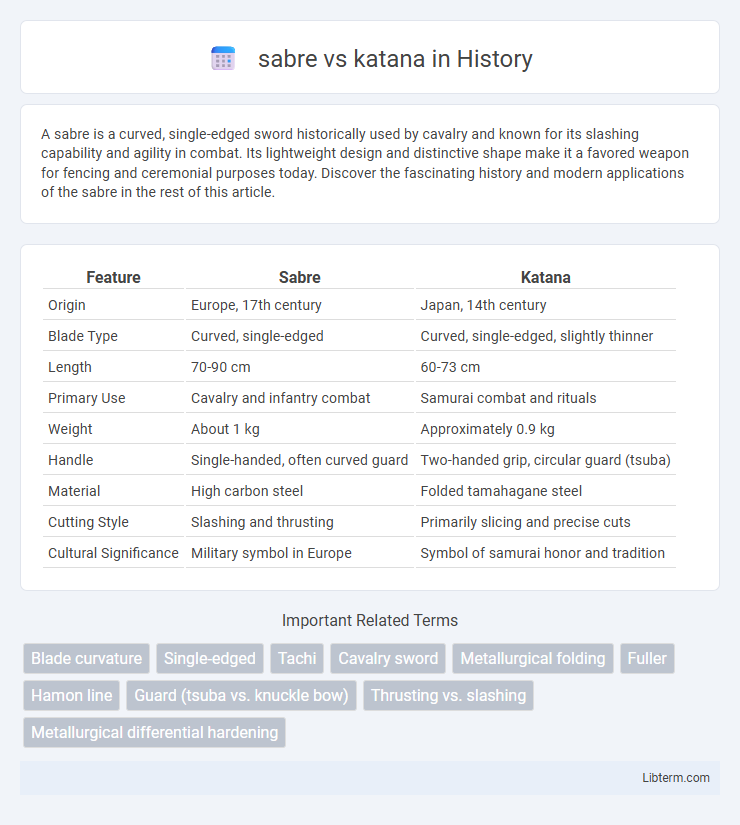A sabre is a curved, single-edged sword historically used by cavalry and known for its slashing capability and agility in combat. Its lightweight design and distinctive shape make it a favored weapon for fencing and ceremonial purposes today. Discover the fascinating history and modern applications of the sabre in the rest of this article.
Table of Comparison
| Feature | Sabre | Katana |
|---|---|---|
| Origin | Europe, 17th century | Japan, 14th century |
| Blade Type | Curved, single-edged | Curved, single-edged, slightly thinner |
| Length | 70-90 cm | 60-73 cm |
| Primary Use | Cavalry and infantry combat | Samurai combat and rituals |
| Weight | About 1 kg | Approximately 0.9 kg |
| Handle | Single-handed, often curved guard | Two-handed grip, circular guard (tsuba) |
| Material | High carbon steel | Folded tamahagane steel |
| Cutting Style | Slashing and thrusting | Primarily slicing and precise cuts |
| Cultural Significance | Military symbol in Europe | Symbol of samurai honor and tradition |
Introduction to Sabre and Katana
The sabre is a curved, single-edged sword historically favored by cavalry units for its slashing capabilities and swift, agile combat style. The katana, a traditional Japanese sword characterized by its distinctive curved blade and sharp edge, is renowned for precision cutting and embodies the samurai's code of honor. Both weapons reflect unique cultural and functional design elements that influenced their respective martial traditions.
Historical Origins and Cultural Context
The sabre originated in Central Asia and Eastern Europe, becoming a prominent weapon among cavalry units such as the Hungarian hussars and Ottoman soldiers during the 17th and 18th centuries. The katana, developed in feudal Japan, served as the iconic weapon of samurai warriors from the Kamakura period (1185-1333) through the Edo period (1603-1868), embodying the warrior's honor and precise craftsmanship. Both blades reflect unique cultural values: the sabre emphasizes speed and cavalry combat, while the katana represents mastery, discipline, and close-quarters swordsmanship.
Blade Design and Construction
Sabres feature a curved, single-edged blade designed for slashing, typically constructed with a flexible steel that absorbs impact and allows for swift, fluid movements. Katanas have a distinct curved, single-edged blade made through differential heat treatment, resulting in a hard, sharp edge and a softer spine for resilience and precision cutting. The sabre's blade emphasizes agility and versatility in horseback combat, while the katana's blade prioritizes sharpness and durability for close-quarters swordsmanship.
Materials Used in Sabre and Katana
Sabres are typically forged from tempered high-carbon steel or stainless steel alloys, designed for flexibility and durability to withstand heavy cavalry use. Katanas are traditionally crafted using tamahagane steel, folded multiple times to create layers that enhance strength, sharpness, and resilience. The differential hardening technique applied in katana blades creates a harder edge and a softer spine, optimizing cutting ability and shock absorption.
Weight, Balance, and Handling
Sabres typically weigh between 2.5 to 3 pounds, offering a balanced design with a curve that enhances cutting efficiency and swift handling, ideal for cavalry use. Katanas, weighing around 2.2 to 2.6 pounds, feature a straighter balance focused near the guard, providing precise control suited for close-quarter combat. The sabre's weight distribution facilitates quick slashing motions, while the katana's balance emphasizes sharp, controlled strikes with a smooth draw.
Intended Use and Fighting Techniques
The sabre, designed primarily for cavalry and light infantry, excels in cutting and slashing due to its curved blade, making it ideal for swift, sweeping attacks and parrying in mounted combat. The katana, crafted for samurai warriors, features a single-edged, slightly curved blade optimized for precise cutting, drawing techniques, and fluid, controlled strikes in close-quarters battle. While the sabre emphasizes speed and mobility with broader slashes, the katana prioritizes accuracy, technique, and efficient, clean cuts in its fighting style.
Differences in Swordsmithing Techniques
Sabres feature curved, single-edged blades crafted through differential hardening to enhance flexibility and cutting power, typical of European and Middle Eastern swordsmithing traditions. Katanas are traditionally forged using folded steel techniques, involving repeated heating, folding, and hammering to create a blade with a distinctive hamon edge and superior sharpness, exemplifying Japanese craftsmanship. The contrasting methods reflect cultural priorities: sabres emphasize agility and slashing efficiency, while katanas focus on blade strength and precise cutting ability.
Significance in Military History
The sabre and katana hold distinct significance in military history, with the sabre widely used by European cavalry from the 18th to 19th centuries, known for its curved blade facilitating powerful slashing attacks during horseback combat. The katana, iconic in Japanese samurai culture, symbolized discipline and skill, its design optimized for quick, precise cutting in close-quarters warfare during feudal Japan. Both weapons reflect their respective martial traditions and technological advancements, influencing combat tactics and cultural heritage profoundly.
Modern-Day Applications and Collecting
Sabres are favored in ceremonial military roles and historical reenactments due to their curved blades optimized for slashing, while katanas are highly prized by collectors for their craftsmanship, cultural significance, and sharpness. Modern martial artists practicing traditional Japanese swordsmanship often use katanas, whereas sabres appear in cavalry displays and equestrian sports. Collectors value katanas with authentic signatures (mei) and tamahagane steel, whereas sabres with period-specific markings and provenance enhance their historical and monetary worth.
Conclusion: Sabre vs Katana—Which Is Superior?
The katana excels in precision and cutting power with its curved, single-edged steel blade designed for swift, decisive strikes. The sabre offers versatility and thrusting capability, featuring a lighter blade and hand guard optimized for cavalry combat and quick parries. Choosing between sabre and katana depends on the intended use: the katana dominates in close-quarters slicing efficiency, while the sabre provides balanced offense and defense suited for diverse combat scenarios.
sabre Infographic

 libterm.com
libterm.com